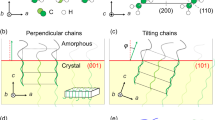Abstract
IT was reported earlier that long-chain polymers could form single crystals in which the molecules have a regularly folded configuration1,2. Polyethylene in particular can have a paraffin-like crystal habit consisting of thin lozenge-shaped layers with each segment of the folded molecular chain normal, or approximately normal, to the plane of these layers. It was suggested3 that the molecules might fold in the plane of the growing faces, which are of the {110} type in the purely lozenge-shaped crystals. This implies that in the four different quadrants the chains are folded along four different <110> directions, and hence that the apparent single crystal consists in fact of four structurally distinct sectors in twin relation. So far as we know, this situation is unprecedented in crystalline substances.
Similar content being viewed by others
References
Keller, A., Phil. Mag., 2, 1171 (1957).
Keller, A., and O'Connor, A., Nature, 180, 1289 (1957).
Keller, A., and O'Connor, A., Disc. Faraday Soc., 25, 141 (1958).
Agar, A. W., Frank, F. C., and Keller, A., Phil. Mag., 4, 32 (1959).
Author information
Authors and Affiliations
Rights and permissions
About this article
Cite this article
BASSETT, D., FRANK, F. & KELLER, A. Evidence for Distinct Sectors in Polymer Single Crystals. Nature 184, 810–811 (1959). https://doi.org/10.1038/184810a0
Issue Date:
DOI: https://doi.org/10.1038/184810a0
- Springer Nature Limited
This article is cited by
-
Reassessing chain tilt in the lamellar crystals of polyethylene
Nature Communications (2023)
-
Structure and plastic deformation of polyethylene
Journal of Materials Science (1994)
-
Anisotropic friction on lamellar crystals of polyethylene by lateral force microscopy
Polymer Bulletin (1994)





